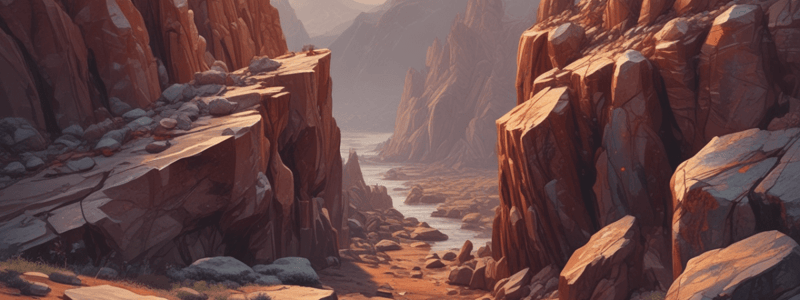Podcast
Questions and Answers
What is the definition of igneous rocks?
What is the definition of igneous rocks?
- Rocks that form from the erosion of mountains.
- Rocks that form from the decomposition of organic matter.
- Rocks that form from the cooling and solidifying of magma or lava. (correct)
- Rocks that form from the compression of sediment.
Where can igneous rocks be found?
Where can igneous rocks be found?
- At the bottom of the ocean, deep underground, and near active volcanoes. (correct)
- Only at the bottom of the ocean.
- Only in mountainous regions.
- Only on land near active volcanoes.
What is the theory that states the Earth's crust is broken up into plates?
What is the theory that states the Earth's crust is broken up into plates?
- Continental drift
- Geological formation
- Rock cycle
- Plate tectonics (correct)
What is the term used to describe the hot, deep layers of the Earth?
What is the term used to describe the hot, deep layers of the Earth?
What do tectonic plates float on?
What do tectonic plates float on?
What is the process that leads to the formation of igneous rocks?
What is the process that leads to the formation of igneous rocks?
What is the analogy used to describe the Earth's crust broken up into plates?
What is the analogy used to describe the Earth's crust broken up into plates?
What is the primary condition required for the formation of igneous rocks?
What is the primary condition required for the formation of igneous rocks?
What occurs when tectonic plates diverge?
What occurs when tectonic plates diverge?
What is the Mid-Atlantic Ridge an example of?
What is the Mid-Atlantic Ridge an example of?
What happens to the subducting plate in a subduction zone?
What happens to the subducting plate in a subduction zone?
What is the characteristic of the oceanic crust that causes it to subduct under the continental crust?
What is the characteristic of the oceanic crust that causes it to subduct under the continental crust?
What is the result of the convergence of tectonic plates in the Ring of Fire?
What is the result of the convergence of tectonic plates in the Ring of Fire?
What is the ultimate fate of the melted rock in a subduction zone?
What is the ultimate fate of the melted rock in a subduction zone?
What is the primary process that forms igneous rocks?
What is the primary process that forms igneous rocks?
Flashcards are hidden until you start studying
Study Notes
Igneous Rocks
- Form from the cooling and solidifying of magma or lava
- Can be found at the bottom of the ocean, deep underground, and on active volcanic mountains
- Formation is linked to the movement of tectonic plates
Tectonic Plates
- Theory of plate tectonics states that the Earth's crust is broken into plates
- Massive plates of the earth's crust that can move and float on top of hot, deep layers of the earth
- Plates can either get closer together or drift apart, leading to igneous rock formation
Diverging Tectonic Plates and Igneous Rocks
- As plates move apart, magma from below the crust squeezes up through the gap and reaches the surface
- formation of igneous rocks occurs as magma meets cooler temperatures and solidifies
- Examples: Mid-Atlantic Ridge, a continuous mountain chain located under the surface of the sea
Converging Tectonic Plates and Igneous Rocks
- Igneous rocks form where plates bump up against each other
- Plates converge, creating a subduction zone where one plate is pushed under another
- Subducting plate melts, forming magma that rises towards the surface, solidifying into igneous rock
- Examples: Ring of Fire, an area bordering the Pacific Ocean with extensive volcanic activity
Studying That Suits You
Use AI to generate personalized quizzes and flashcards to suit your learning preferences.



